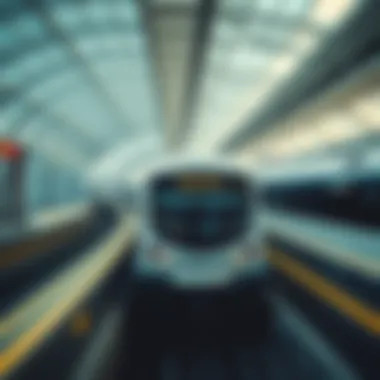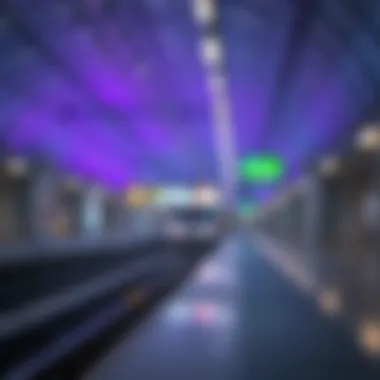Understanding the Operational Timings of Dubai Metro


Intro
Navigating a bustling metropolis like Dubai can often feel like trying to find a needle in a haystack. With its sprawling landscape and rapid pace, understanding how to get around is essential for both residents and visitors alike. The Dubai Metro stands at the forefront of the city's transport network, orchestrating an efficient flow of passengers across key destinations. This article aims to break down the operational timings of the Dubai Metro, highlighting how these schedules play a crucial role in the urban transit ecosystem and what that means for potential commuters and investors alike.
Market Trends
As the Dubai landscape evolves, so too does its real estate market. With the metro's operational timings that cater to peak hours, it's vital for investors to remain attuned to how these timings intersect with property values. Currently, the market demonstrates resilience, characterized by a steady influx of investors looking for opportunities near metro stations.
Current Real Estate Market Insights
The increasing convenience of transit options significantly affects property demand. Areas situated near metro stations often experience higher property values. For example, districts like Dubai Marina and Downtown Dubai are particularly attractive for potential buyers and tenants looking for easy access to transportation. These regions showcase a blend of high-end residential buildings and commercial establishments, making them hot spots for real estate investment.
- The thriving tourism sector boosts the demand for short-term rentals near metro stops.
- As the metro expands, newer neighborhoods are expected to develop, enhancing their market appeal.
Future Predictions and Investment Opportunities
Looking down the line, the Dubai Metro is set for further expansions, potentially increasing accessibility to previously underserved areas. New lines on the horizon could change the market dynamics altogether, creating ripe opportunities for investors to consider. It is crucial to keep an eye on proposals aligned with city developments. Key predictions include:
- Growth in Demand: Expect an uptick in interest for properties near upcoming metro stations.
- Competitive Pricing: As the market evolves, prices for property listings may fluctuate.
- Shift in Buyer Preferences: Homebuyers will increasingly prefer locations that offer convenient access to public transportation.
"Investments tied closely to transit infrastructure tend to yield substantial returns, particularly in a city known for transformational growth like Dubai."
Property Listings
When considering property investments around the Dubai Metro, it is essential to look into both luxurious listings and more affordable options. Understanding the balance between lavish amenities and budget-conscious choices helps tailor the search according to individual or investor needs.
Featured Luxury Properties
- Burj Khalifa View Apartments: Located near the Dubai Mall Metro Station, these high-end residences attract both foreign and local buyers seeking opulence.
- The Address Residence Dubai Marina: Combining elegance and convenience, these homes offer unmatched access to the metro and chic waterfront living.
Affordable Housing Options
On the flip side, those looking for budget-friendly options can find several properties close to metro stations:
- Jumeirah Village Circle (JVC): Offers reasonably priced apartments with connections to the metro, attracting young professionals.
- Al Qusais: An up-and-coming neighborhood providing value-for-money housing while maintaining proximity to public transport.
In summary, understanding the operational timings of the Dubai Metro and their implications on real estate can open doors to exciting opportunities for investors and homebuyers. Knowing exactly when the metro runs and how it syncs with daily life will pave the way for better decision-making, making the search more efficient and ultimately rewarding.
Overview of Dubai Metro
The Dubai Metro is more than just a system of trains; it is a cornerstone of the urban landscape in one of the fastest-growing cities in the world. By examining this aspect, readers can gain insights into the efficient organization of a sprawling metropolis and the critical role public transport plays in enhancing urban functionality. For investors and realtors, understanding the metro’s operations provides valuable information regarding accessibility, property values, and overall community development. The infrastructure in Dubai not only eases commuting but also supports the economic fabric of the city by connecting various neighborhoods and commercial districts.
Preamble to the Metro System
The Dubai Metro was inaugurated in 2009, a commitment to modernity and sustainability that reflects the city's ambitions. Comprising the Red and Green Lines, the system stretches over 75 kilometers, with a significant number of stations covering vital parts of the city. Each station has been designed to cater to passenger needs—comfortable waiting areas, clear signage, and even retail spaces that enhance the experience for commuters. The metro features driverless trains, showcasing advanced technology and offering a glimpse into future urban transportation technologies.
Passengers appreciate the convenience afforded by the metro, as it offers a reliable and swift alternative to road traffic. The air-conditioned coaches provide a comfortable ride, making commuting during hot summer days notably more bearable. Moreover, the automated systems help to ensure timely departures and arrivals, thus reducing the waiting time for passengers and creating a rhythm to daily travel.
Importance of Public Transport
Public transport is vital for multiple reasons, particularly in a city like Dubai where the population density continues to soar. The metro reduces reliance on personal vehicles, thereby alleviating congestion on busy roads—an issue that is ever-present in major urban locales. Moreover, it actively contributes to lowering carbon emissions, aligning with global sustainability goals. Having a robust public transport system encourages a shift in mindset among residents; it fosters a culture of shared mobility, which is increasingly sought after in urban planning.
The metro also plays an economic role by facilitating job opportunities. For instance, workers can access employment zones across the city effortlessly.


- Key Benefits of the Dubai Metro:
- Sustainability: Reduces traffic congestion and lowers emissions.
- Accessibility: Offers a comprehensive network connecting diverse areas effectively.
- Economic Growth: Stimulates local business by improving foot traffic in commercial areas.
"Public transport systems like the Dubai Metro are essential in shaping the future of urban living, balancing growth with sustainability."
The metro is also an attractive option for tourists, providing a convenient way to visit popular sites without the hassle of driving or navigating local traffic regulations. This accessibility not only enhances the travel experience but also promotes various attractions across the city, ultimately supporting the robust tourism sector that's vital for Dubai’s economy.
Ultimately, understanding how the Dubai Metro functions and its significance in the broader transport network is crucial for anyone considering investment or residing in this vibrant city. The interplay between the metro system and urban development becomes increasingly important, particularly as the city continues to expand and evolve.
Metro Operating Hours
Understanding the operating hours of the Dubai Metro is crucial for anyone looking to navigate the bustling metropolis. The timing of the metro services is more than just a schedule; it plays a significant role in shaping the daily rhythms of the city. Those who rely on public transport for their commute, including investors, homebuyers, and realtors, must grasp how these hours can affect their plans and overall experience in Dubai.
The operational hours reflect the city’s commitment to efficient public transport, aiming to enhance connectivity while accommodating the diverse needs of its residents and visitors. When planning any journey, having a clear picture of the metro’s timing can help ensure smoother travels and timely arrivals.
Weekday Timings
Weekdays are usually a whirlwind of activity in Dubai, and the metro operates accordingly. Typically, the Metro begins service at 6 AM and runs until midnight, providing ample time for commuters heading to work, appointments, or meetings.
During this period, it’s worth noting that the frequency of the trains increases significantly, particularly during peak hours, which fall between 7 AM to 9 AM and 5 PM to 8 PM. This is when the metro serves its largest volume of passengers, and trains come every few minutes to accommodate the rush.
Being accustomed to the metro timings means less waiting around and more time efficiently doing business.
Weekend Schedule
As the sun sets on Friday, the weekend begins. The Dubai Metro transitions to its weekend operations, which is typically from 9 AM to 1 AM on Saturdays and carries a slightly shortened timetable on Fridays, operating from 1 PM through midnight. While the weekend hours are less stringent, the metro still makes forges ahead with a schedule that allows leisurely exploration of the city.
For those exploring Dubai’s shopping malls or cultural sights, the later hours on Saturdays ensure you can make the most of a full day without worrying about transportation. In contrast, Fridays are often slower, reflecting a more relaxed pace, although many still opt for the metro to venture out for leisure.
Public Holidays Adjustments
Dubai is known for its vibrant celebrations, and public holidays often bring about special schedules for the metro. Adjustments are made to align with festivity schedules so that everyone can enjoy the occasion without the hassle of transportation issues.
During holidays such as Eid or National Day, the metro may have modified hours, usually extending longer into the night to accommodate increased demand. It’s advised to check the Dubai Roads and Transport Authority’s official announcements for any changes in order to plan your travel effectively.
"Knowing the opening times during holidays can save you a lot of hassle and ensure you don’t miss out on any festivities during your stay."
Navigating these timing intricacies not only enhances the commuter experience but also underpins the importance of timing in an ever-evolving urban landscape. Understanding the operating hours of the Dubai Metro is integral for anyone looking to leverage the immense potential of Dubai, be it for work, pleasure, or investment.
Frequency of Services
Understanding the frequency of Dubai Metro services is essential for anyone looking to navigate the bustling city effectively. This aspect of the metro system plays a pivotal role in ensuring seamless connectivity across various neighborhoods. With a reliable service frequency, commuters can plan their journeys more efficiently, minimizing wait times and optimizing travel schedules. Whether you are an investor probing the real estate market or a homebuyer eyeing properties near transit hubs, comprehending the metro’s frequency can enhance your decision-making process.
Furthermore, it fosters the convenience that many residents and tourists seek, allowing for a smoother flow of daily activities. The availability of frequent trains contributes significantly to the overall public transport experience and, thus, influences urban development patterns, including property values and economic growth.
Peak Hours Frequency
During peak hours, the frequency of Dubai Metro trains catapults to its zenith. This period generally spans from 7:00 AM to 9:00 AM and later from 5:00 PM to 8:00 PM from Sunday to Thursday. Trains operate every two to three minutes during these high-traffic times, ensuring that commuters can access their destinations without prolonged delays.
The surge in frequency during these hours caters primarily to the vast number of workers who rely on the metro to commute to and from their workplaces. Ducks and drakes are made to slip into the ranks quickly, as the metro becomes a lifeline for thousands of individuals hustling to start or end their day. It's advisable to avoid the busiest trains if you prefer a more relaxed commute experience.
Off-Peak Frequency
Conversely, when the hustle and bustle dwindles, the Dubai Metro still operates with notable efficiency. Off-peak hours typically encompass times outside of the morning and evening rush, like mid-mornings from 9:00 AM to 11:00 AM and afternoons after 2:00 PM till 4:00 PM. During these times, the wait time between trains might extend to six to eight minutes.


This maybe seems like a minor inconvenience? Not really! Knowing this can allow you to schedule your trips effectively, particularly if you’re heading to less busy destinations or planning errands around town.
In summary, understanding the frequency of metro services in Dubai can enhance both daily commutes and longer excursions throughout the city. Be it peak or off-peak service, knowing when to travel can save time and make for a more pleasant experience on the metro.
Key Metro Lines and Stations
The Dubai Metro stands as a cornerstone of the city’s public transportation framework. Its lines stretch across pivotal areas, linking communities, business hubs, and lifestyle destinations. Knowing the key metro lines and stations is essential not just for commuters, but also for investors, homebuyers, realtors, analysts, and developers looking to harness the full potential of Dubai's urban structure.
Red Line Overview
The Red Line is often considered the lifeline of the Dubai Metro. Spanning approximately 52 kilometers, this line runs from Rashidiya to UAE Exchange and connects a multitude of landmarks such as the Dubai Mall, Burj Khalifa and the Dubai Marina.
- Stations: With a total of 29 stations, the Red Line features significant stops that facilitate easy access to shopping, dining, and office spaces. Key stations include Dubai Healthcare City, an emerging hub for medical tourism, and Business Bay, which is a hotspot for corporate offices.
- Benefits: Commuters using the Red Line benefit from its direct routes and frequent trains, especially during peak hours. The connectivity to other modes of transportation - such as buses and trams - vastly improves mobility across the city.
- Considerations: For investors and buyers, proximity to the Red Line can heavily influence property values. Being near a station could mean a premium on real estate prices, making it vital to consider this aspect when evaluating potential investment opportunities.
Green Line Overview
Running parallel to the Red Line, the Green Line offers a more localized experience, intersecting with not only residential areas but also cultural sites. Extending 22.5 kilometers from Dubai Creek to Etisalat, this line champions accessibility in densely populated and historically rich neighborhoods.
- Stations: The Green Line includes 20 stops, linking places like Al Ghubaiba, with its historical significance, and Al Jafiliya, which provides access to various cultural attractions.
- Benefits: The stations on the Green Line cater to a diverse populace, including students and professionals. With educational institutions situated near its route, many commuters utilize this line for daily travel to schools and universities, enhancing student mobility immensely.
- Considerations: Real estate near the Green Line may cater more to residents rather than commercial entities. Understanding the demographic trends of the area can assist investors in making informed decisions regarding property acquisition.
Future Extensions
Dubai is never one to rest on its laurels. Plans to extend both the Red and Green Lines reflect the city's growth ambitions. Significant extensions are on the cards, promising to add additional links and enhance reach.
- New Connections: Upcoming stations aim to serve newly established developments, such as Dubai South, which is positioning itself as a futuristic city in its own right, and Jumeirah Village Circle, a community outpost with broad appeal to families.
- Impact on Urban Development: The expansions stand to increase access to emerging neighborhoods and redefine commuting patterns entirely. This could lead to rising property values in areas previously considered out of reach, driving interest from developers and investors.
"The expansion of the Dubai Metro will not only ease congestion but also stimulate economic growth around new transit points, making it crucial for those invested in the real estate market to stay informed."
Understanding Key Metro Lines and Stations is fundamental for navigating Dubai, whether for daily commutes or long-term investments. Keeping an eye on developments and the patterns they create can provide insights that go far beyond mere transportation.
Commuter Experience
The commuter experience on the Dubai Metro plays a critical role in the daily lives of residents and visitors. It's not just about the nuts and bolts of trains running on time; it's about how smoothly people can travel from one point to another, which in turn influences their perceptions of the city and its connectivity. As urban landscapes evolve, so do the expectations of commuters. A well-run metro system enhances quality of life, reduces congestion on roads, and fosters a sense of community among riders.
Ticketing System and Fares
Navigating the ticketing system is the first step for most metro users. Dubai Metro employs a smart Nol card system, which offers extensive flexibility for passengers. Commuters can recharge their cards at various locations or through mobile applications—making it straightforward to get a ticket without the hassle of long queues.
- Fare Structure: The pricing is based on zones, with a single journey costing anywhere from AED 3 to AED 7.5, depending on the distance traveled. For frequent riders, a monthly pass is available at a reasonable rate, catering to those who rely on the metro as their primary mode of transport.
- Discounts: Students, seniors, and people with disabilities can benefit from concessions, ensuring affordability for all, and encouraging more rides.
The Nol card is not only a means for purchasing tickets but also serves as a way to track your travel habits—offering insights into how often, and how far you are traveling.
Accessibility Features
The Dubai Metro prides itself on being accessible to everyone, including those with mobility challenges. Stations are equipped with elevators and ramps, ensuring ease of access. Additionally, there are dedicated spaces for wheelchairs and prams onboard the trains, which is a thoughtful touch.
Key Accessibility Features include:
- Audio and Visual Announcements: Information is relayed in multiple formats to assist all passengers.
- Trained Staff: Metro staff undergo training to assist travelers with special needs, ensuring that help is never more than a moment away.
- Information Desks: At major stations, specifically designated help desks provide additional support, catering to those who may have questions or need assistance.
Safety Protocols
Safety is paramount in any public transport system, and Dubai Metro is no exception. The metro’s design incorporates numerous safety features, minimizing risks. Regular maintenance ensures that the trains and tracks remain in optimal condition.
Key Safety Measures include:


- CCTV Surveillance: Cameras are installed throughout the system to monitor activities, enhancing security for all passengers.
- Emergency Protocols: Trains are equipped with various safety equipment, and staff are trained to handle emergencies effectively.
- Health and Hygiene: In light of recent global health concerns, additional cleaning measures have been implemented to maintain hygiene, providing peace of mind for the wary commuter.
Impact on Urban Development
Understanding the impact of the Dubai Metro on urban development provides a comprehensive view of how this transport system intertwines with city planning and growth. In a city like Dubai, where rapid development is the norm, the metro serves not just as a transportation option, but as a catalyst for widespread urban transformation. The following points highlight key aspects that illustrate the significance of the metro system in shaping the urban landscape.
Connecting Communities
One of the most notable features of the Dubai Metro is its ability to connect communities across the city. With various stops that span from the busy streets of Deira to the futuristic landscapes of Dubai Marina, this metro system has dramatically reduced travel time for residents and visitors alike. For instance, a journey that used to take an hour in a car can often be completed in half the time via train, fostering ease of movement.
- Community Integration: The metro promotes a sense of belonging among residents; as neighborhoods are linked more closely, they begin to share amenities and resources. This connectivity makes it easier for people to access parks, businesses, leisure activities, and educational institutions.
- Social Services Access: For many individuals, especially those without vehicles, the metro grants access to essential services. It unshackles those in suburbs from isolation, enabling them to partake in city life, job opportunities, and cultural experiences, enriching their overall quality of life.
“The Dubai Metro is more than just a transit system; it’s a lifeline that forges connections between people and places.”
Influence on Property Prices
The ripple effect of the metro on property values cannot be overstated. With few exceptions, properties within close proximity to metro stations generally command higher prices due to heightened demand. Prospective buyers often seek residences that offer easy access to public transport for convenience and time-saving.
- Market Demand: Developers and investors have taken note. When they position their projects near metro stations, they capitalize on the influx of buyers eager for accessibility. High-rise apartments and commercial spaces flourish in these prime locations, creating a self-reinforcing cycle where increased foot traffic leads to further investments by businesses.
- Long-term Investments: For real estate investors, properties near metro lines represent more than just current value; they embody the future potential of the area's growth. By choosing to invest near metro stations, buyers are banking on the city's commitment to improving transportation infrastructure as a driver for economic growth and enhanced property desirability.
Navigating Dubai by Metro
Navigating Dubai by Metro is essential for anyone looking to explore the city efficiently. The Metro system not only connects key areas but also serves as a cornerstone of Dubai’s transportation network. Commuters benefit from fast travel times and reduced traffic congestion. Understanding how to maneuver through the Metro is especially relevant for potential investors, homebuyers, and real estate professionals.
When planning your journey, understanding the Metro layout and the schedule times allows for strategic decision-making. Being aware of the peak hours and specific train frequencies can help to avoid crowded trains. Additionally, knowing transfer points to connect with other transport methods can lead to a more seamless travel experience throughout the city.
Planning Your Journey
Planning your journey on the Dubai Metro involves several key considerations. First, understanding the route map can provide clarity on the stations you need. As a city of rapid development, Dubai’s Metro network continually adapts to meet the needs of its growing population.
- Start with the Metro map. Identify where you're starting from and your desired destination. The Metro has made this process simpler by clearly marking each line and its stations.
- Check the timings. Before setting off, it helps to consult the current operational hours peculiar to your intended travel day. Remember that during public holidays, timings might change.
- Utilize the Dubai RTA app. This application provides real-time updates, allowing you to plan ahead.
- Ticketing can also influence your trip. Different fare zones apply based on your travel distance. It’s worth considering the Nol card for multiple trips.
Integrating with Other Modes of Transport
Dubai offers several modes of transportation besides the Metro, which makes connectivity highly efficient. Integrating with other transport methods can enhance the overall commuting experience.
- Buses: The bus network complements the Metro system well. Major Metro stations are often linked to bus stops, making it easy for passengers to switch modes without long delays.
- Taxis and Ride-sharing services: In a pinch, taxis are available near major stations. Platforms like Careem and Uber also have designated pick-up and drop-off areas.
- Water Transport: For those seeking a unique perspective of the city, water taxis and abras can provide an enjoyable and picturesque means of transport along Dubai's waterways.
Consulting the Dubai Roads and Transport Authority (RTA) for information on these integrations can further streamline your travel experience, ensuring you arrive at your destination smoothly and efficiently.
To conclude, as you navigate through Dubai using its Metro system, a thorough understanding of the routes, timings, and alternative modes of transport can make your journey incredibly effective. Whether for leisure or securing that lucrative real estate deal, information is your best ally in this vibrant city.
Culmination
The conclusion of this article serves as a pivotal moment in synthesizing the various aspects related to Dubai's Metro system. A short summary here can encapsulate why understanding these timings is not just about commuting; it's about grasping the very essence of urban movement in a bustling metropolis. The Metro stands as a living example of how public transport can evolve and adapt to the fast-paced life in a city like Dubai.
Summary of Key Points
Bringing together the core insights shared throughout the article, we can identify several key takeaways:
- Metro Operating Hours: Convenience is at the heart of the Metro’s operational hours, striking a delicate balance between commuter needs and urban life.
- Frequency of Services: The variation between peak and off-peak frequencies is designed to accommodate the dynamic flow of passengers, ensuring that public transport remains a viable option for all.
- Impact on Urban Development: The Metro not only connects different parts of the city but also influences property prices, making it a crucial element for investors and homebuyers.
- Navigational Tips: The integration of Dubai Metro with other modes of transport allows seamless commute options, enhancing overall ease of movement.
In understanding these components, commuters, realtors, and urban planners alike can appreciate the strategic importance of the Dubai Metro within the broader urban landscape.
Future Considerations
As we look ahead, there are several factors worth considering about the future of Dubai Metro and its operational timings:
- Expansion Plans: Anticipated expansions are set to enhance connectivity further, suggesting that potential commuters should stay updated on future service adjustments.
- Technological Advances: The possible incorporation of smart technology may lead to more personalized travel experiences, potentially impacting future schedules.
- Urban Growth: As Dubai continues its rapid development, demographic shifts could necessitate changes to the current operating timings, making adaptability crucial.
These considerations highlight the ongoing evolution of public transport in Dubai and its relevance for all stakeholders. By staying informed about the Metro timings and trends, individuals can make educated decisions, whether it’s commuting efficiently or investing right in the fast-growing real estate market.















